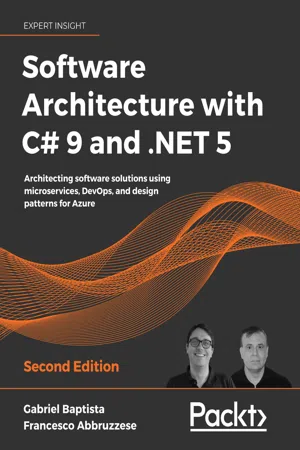
Software Architecture with C# 9 and .NET 5
Architecting software solutions using microservices, DevOps, and design patterns for Azure, 2nd Edition
- 700 pages
- English
- ePUB (mobile friendly)
- Available on iOS & Android
Software Architecture with C# 9 and .NET 5
Architecting software solutions using microservices, DevOps, and design patterns for Azure, 2nd Edition
About This Book
Design scalable and high-performance enterprise applications using the latest features of C# 9 and.NET 5
Key Features
- Gain fundamental and comprehensive software architecture knowledge and the skillset to create fully modular apps
- Design high-performance software systems using the latest features of.NET 5 and C# 9
- Solve scalability problems in web apps using enterprise architecture patterns
Book Description
Software architecture is the practice of implementing structures and systems that streamline the software development process and improve the quality of an app. This fully revised and expanded second edition, featuring the latest features of.NET 5 and C# 9, enables you to acquire the key skills, knowledge, and best practices required to become an effective software architect.
This second edition features additional explanation of the principles of Software architecture, including new chapters on Azure Service Fabric, Kubernetes, and Blazor. It also includes more discussion on security, microservices, and DevOps, including GitHub deployments for the software development cycle.
You will begin by understanding how to transform user requirements into architectural needs and exploring the differences between functional and non-functional requirements. Next, you will explore how to carefully choose a cloud solution for your infrastructure, along with the factors that will help you manage your app in a cloud-based environment.
Finally, you will discover software design patterns and various software approaches that will allow you to solve common problems faced during development.
By the end of this book, you will be able to build and deliver highly scalable enterprise-ready apps that meet your organization's business requirements.
What you will learn
- Use different techniques to overcome real-world architectural challenges and solve design consideration issues
- Apply architectural approaches such as layered architecture, service-oriented architecture (SOA), and microservices
- Leverage tools such as containers, Docker, Kubernetes, and Blazor to manage microservices effectively
- Get up to speed with Azure tools and features for delivering global solutions
- Program and maintain Azure Functions using C# 9 and its latest features
- Understand when it is best to use test-driven development (TDD) as an approach for software development
- Write automated functional test cases
- Get the best of DevOps principles to enable CI/CD environments
Who this book is for
This book is for engineers and senior software developers aspiring to become architects or looking to build enterprise applications with the.NET Stack. Basic familiarity with C# and.NET is required to get the most out of this book.
Frequently asked questions
Information
15
Presenting ASP.NET Core MVC
- Understanding the presentation layers of web applications
- Understanding the ASP.NET Core MVC structure
- What is new in the latest versions of ASP.NET Core?
- Understanding the connection between ASP.NET Core MVC and design principles
- Use case – implementing a web app in ASP.NET Core MVC
Technical requirements
Understanding the presentation layers of web applications
- Mobile or desktop native applications that exchange data with servers through REST or SOAP services: We have not discussed them since they are strictly tied to the client device and its operating system. Therefore, analyzing them, which would require a dedicated book, is completely beyond the scope of this book.
- Single-Page Applications (SPAs): These are HTML-based applications whose dynamic HTML is created on the client either in JavaScript or with the help of WebAssembly (a kind of cross-browser assembly that can be used as a high-performance alternative to JavaScript). Like native applications, SPAs exchange data with the server through REST or SOAP services, but they have the advantage of being independent of the device and its operating system since they run in a browser. Chapter 16, Blazor WebAssembly, describes the Blazor SPA framework, which is based on WebAssembly, since it is based itself on a .NET runtime compiled in WebAssembly.
- HTML pages created by the server whose content depends on the data to be shown to the user: The ASP.NET Core MVC framework, which will be discussed in this chapter, is a framework for creating such dynamic HTML pages.
Understanding the ASP.NET Core MVC structure
Startup class defined in the Startup.cs file by calling the .UseStartup<Startup>() method of the IWebHostBuilder interface. ConfigureServices(IServiceCollection services) of the Startup class defines all services that can be injected into object constructors through Dependency Injection (DI). DI was described in detail in the Using generic hosts subsection of Chapter 5, Applying a Microservice Architecture to Your Enterprise Application.Configure(IApplicationBuilder app, IWebHostEnvironment env) startup method defines the so-called ASP.NET Core pipeline, which was briefly described in the A short introduction to ASP.NET Core subsection of Chapter 14, Applying Service-Oriented Architectures w...Table of contents
- Preface
- Understanding the Importance of Software Architecture
- Non-Functional Requirements
- Documenting Requirements with Azure DevOps
- Deciding the Best Cloud-Based Solution
- Applying a Microservice Architecture to Your Enterprise Application
- Azure Service Fabric
- Azure Kubernetes Service
- Interacting with Data in C# – Entity Framework Core
- How to Choose Your Data Storage in the Cloud
- Working with Azure Functions
- Design Patterns and .NET 5 Implementation
- Understanding the Different Domains in Software Solutions
- Implementing Code Reusability in C# 9
- Applying Service-Oriented Architectures with .NET Core
- Presenting ASP.NET Core MVC
- Blazor WebAssembly
- Best Practices in Coding C# 9
- Testing Your Code with Unit Test Cases and TDD
- Using Tools to Write Better Code
- Understanding DevOps Principles
- Challenges of Applying CI Scenarios
- Automation for Functional Tests
- Answers
- Another Book You May Enjoy
- Index